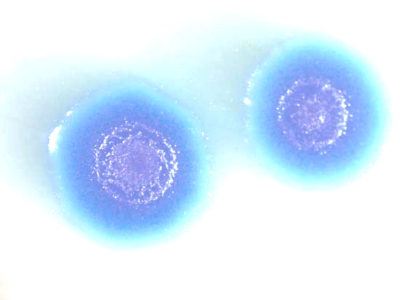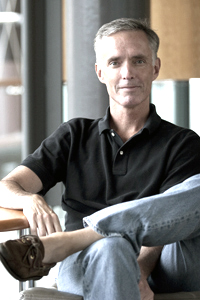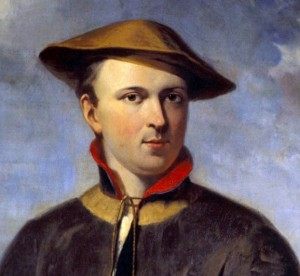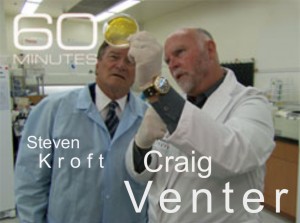 Craig Venter, the maverick American biologist and businessman, captured worldwide attention by announcing the creation of “the first synthetic species,” nicknamed “Synthia.” Venter has the credentials. In 2000, Venter, along with Francis Collins of the National Institutes of Health, jointly announced the complete mapping of the human genome.
Craig Venter, the maverick American biologist and businessman, captured worldwide attention by announcing the creation of “the first synthetic species,” nicknamed “Synthia.” Venter has the credentials. In 2000, Venter, along with Francis Collins of the National Institutes of Health, jointly announced the complete mapping of the human genome.
In a 60-Minute CBS interview with Steve Kroft (pictured right), in the aired TV segment entitled “J. Craig Venter: Designing Life,” CBS touted that Venter’s new synthetic species “gets its genetic instructions from a synthetic chromosome made by man, not nature.”
Venter’s $40 million investment was a fifteen-year project. In May, Venter’s team published their report entitled “Creation of a Bacterial Cell Controlled by a Chemically Synthesized Genome” in the prestigious Science journal.
Project Report
After sequencing the Mycoplasma mycoides (pictured above left) genome, the team assembled modified synthetic sequences followed by transplantation into the cytoplasm of the subspecies recipient Mycoplasma capricolum. In summary, the team reports –
“We now have combined all of our previously established procedures and report the synthesis, assembly, cloning, and successful transplantation of the 1.08-Mbp M. mycoides JCVI-syn1.0 genome to create a new cell controlled by this synthetic genome.”
Following more than 30 cell divisions, the progeny of the recipient did not contain any protein molecules that were present in the original recipient cell, demonstrating that the modified donor synthetic M. mycoides genome gained complete control of the recipient M. capricolum cell.
The implications of synthetic biology have not gone unnoticed. In their paper, the team concludes –
“If the methods described here can be generalized, design, synthesis, assembly, and transplantation of synthetic chromosomes will no longer be a barrier to the progress of synthetic biology… As synthetic genomic applications expand, we anticipate that this work will continue to raise philosophical issues that have broad societal and ethical implications.
The selection of M. mycoides, a genetically simple and fast-growing organism with a single known subspecies, was critical. Although M. mycoides has over 900 genes, the team used only 473. By comparison, bacteria, such as Escherichia coli, have 4,000 to 5,000 genes, and humans have more than 22,000 genes.
In the controlled conditions of the laboratory, the resulting organism was self-replicating.
Implications
 In the journal Nature, published letters commenting on the report were mostly neutral. According to molecular biologist Jim Collins of Boston University –
In the journal Nature, published letters commenting on the report were mostly neutral. According to molecular biologist Jim Collins of Boston University –
“Its [Venter’s] genome is a stitched-together copy of the DNA of an organism that exists in nature, with a few small tweaks thrown in.”
Mark Bedauv of Reed College in Portland, Oregon, called Venter’s new species “a normal bacterium with a prosthetic genome.”
The report drew international attention, with the UK’s DailyMail drawing its share of sensational comments. According to Pat Mooney, of the ETC Group, a technology watchdog specializing in synthetic biology –
“This is a Pandora’s box moment – like the splitting of the atom or the cloning of Dolly, the sheep, we will all have to deal with the fallout from this alarming experiment.”
For Oxford University ethicist Julian Savulescu –
“Venter is creaking open the most profound door in humanity’s history, potentially peeking into its destiny.”
CNN and the Associated Press covered Venter’s paper. In a CNN interview, to the question, “What exactly have you done?” vastly over-simplifying the study, Venter explained –
“We announced the first cell that is totally controlled by a synthetic chromosome, that we designed in a computer-based on an existing chromosome. We built it from four bottles of chemicals.”
Evolution Implications
This first synthetic species project was challenging. Unexpectedly, even detecting the organism’s essential gene was a difficult task. Starting in 1995, the team took 15 years to build “a minimal cell that contains only essential genes” in the laboratory. Scientific evidence for any of evolution’s “slight, successive changes” by means of natural selection was not apparent.
Successive generations of “Synthia” required the removal of more than 100 of the original 485 protein-coding genes, with an average gene size of 6-kilo base pairs (kbp). For reference, the average gene size in humans is 10 – 15 kbp. Genetically, Mycoplasma is one of nature’s minimally complex organisms.
Even in this relatively simple gene, determining how to disable the recipient’s restrictive defense mechanisms to accept the donor’s DNA proved to be crucial – requiring three different approaches –
“We overcame this restriction barrier by methylating the donor DNA with purified methylases or crude M. mycoides or M. capricolum extracts, or by simply disrupting the recipient cell’s restriction system.”
Mycoplasma capricolum is a subspecies of Mycoplasma mycoides. Subspecies, by definition, are variants of the primary species capable of interbreeding and producing fertile offspring. According to WIKIPEDIA,
“The variation is essentially random and largely meaningless so far as genetic transmission of these variations is concerned.”
Even though the building of the “first synthetic species” in the laboratory is a show-stopping display of genomic technology, the chances of survival in nature remain untested and unknown, undermining their conclusion –
“Synthetic chromosomes will no longer be a barrier to the progress of synthetic biology.”
Given the number of genes studied in this simple organism, more significantly, there was no observable evidence for evolution as predicted by Charles Darwin in The Origin of Species.
Genesis
While the production of the “first synthetic species” using a Mycoplasma species with its variant subspecies was an unprecedented technological wonder, whether it meets the criteria of species remains untested, intensifying the Darwin Dilemma.
Theories, like evolution, are untested ideas. Only scientifically validated theories, however, continue to be compatible with the Genesis account, as the theory of species developed by the Swedish botanist, physician, and zoologist, Carolus Linnaeus (1707-1778). As Linnaeus (pictured left) explains during the Scientific Revolution –
“All the species recognized by Botanists came forth from the Almighty Creator’s hand, and the number of these is now and always will be exactly the same.”
Evidence of extinction and speciation underscores why the theory of evolution remains speculative but not scientifically valid.
First Synthetic Species is an Extinction and Speciation article.
Darwin Then and Now is an educational resource on the intersection of evolution and science, highlighting the ongoing challenges to the theory of evolution.
Move On
Explore how to understand twenty-first-century concepts of evolution further using the following links –
-
- The Understanding Evolution category showcases how varying historical study approaches to evolution have led to varying conclusions. Subcategories include –
- Studying Evolution explains how key evolution terms and concepts have changed since the 1958 publication of The Origin of Species.
- What is Science explains Charles Darwin’s approach to science and how modern science approaches can be applied for different investigative purposes.
- Evolution and Science feature study articles on how scientific evidence influences the current understanding of evolution.
- Theory and Consensus feature articles on the historical timelines of the theory and Natural Selection.
- The Biography of Charles Darwin category showcases relevant aspects of his life.
- The Glossary defines terms used in studying the theory of biological evolution.
- The Understanding Evolution category showcases how varying historical study approaches to evolution have led to varying conclusions. Subcategories include –
2020 Update
In 2010, Venter’s team published a new study entitled “Design and synthesis of a minimal bacterial genome” in the journal Science. The goal was to determine the minimum genome with only the essentials for life. Since the task was more difficult than expected, in conclusion, they report –
“The minimal cell concept appears simple at first glance, but becomes more complex upon close inspection. In addition to essential and nonessential genes, there are many quasi-essential genes, which are not absolutely critical for viability but are nevertheless required for robust growth. Consequently, during the process of genome minimization, there is a trade-off between genome size and growth rate. JCVI-syn3.0 is a working approximation of a minimal cellular genome, a compromise between small genome size and a workable growth rate for an experimental organism. It retains almost all the genes that are involved in the synthesis and processing of macromolecules. Unexpectedly, it also contains 149 genes with unknown biological functions, suggesting the presence of undiscovered functions that are essential for life. JCVI-syn3.0 is a versatile platform for investigating the core functions of life and for exploring whole-genome design.”
According to WIKIPEDIA (2020), in the article, Mycoplasma mycoides, ” the following.
“In 2010, as part of the Minimal Genome Project, a team of the J. Craig Venter Institute synthesized a modified version (JCVI-syn1.0) of the 1,000,000 base pair M. mycoides genome and implanted it into a DNA-free bacterial shell of Mycoplasma capricolum;[7] the resulting organism was shown to be self-replicating.”
“In 2016, the Venter Institute used genes from the JCVI-syn1.0 to synthesize an even smaller genome, which they call JCVI-syn3.0, that contains 531,560 base pairs and 473 genes.[10] A comparison of these two genomes revealed a common set of 256 genes, which the team thinks could represent a minimal set of genes needed for viability.”
Evolution 101 of the University of California, Berkeley, and the Smithsonian Institute does not include any discussion of Venter’s 2010 or 2016 studies.



